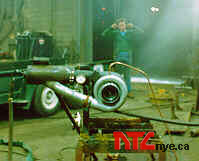NT3

After this, be sure to see: NT/4
After the success with NT/1 we decided to go all out! I bought an old AiResearch T18A40 turbo from a wrecked dump truck. This is a rather large turbo, the type used on 318 Detroit diesel engines. Coincidentally it also happens to be the exact same turbo that the US Air Force used in 1978 for their Ultra Low Cost Turbojet target drone engine project. We had no idea that this had been done before. At the time we were very excited because we thought we invented the turbo charger turbine.
The first jet we built with the new turbo - NT/2 - only survived for one weekend. We chopped it up to build NT/3, so we have no photos of it at all. NT/2 was essentially the same as NT/3 except the combustor was welded-up as one piece and could not be disassembled, everything was totally makeshift at the time, but man did it scream! The following photos show our progress with NT/3.
Phil Matolcsy, friend and co-builder of this, the third Nye Turbo-Jet, is installing the combustor air jacket seal on NT/3. The small-block Chevy oil pump we used for feeding the turbo bearings is seen resting on the bench in the foreground.
This photo shows the combustor and turbine side of NT/3 mounted on a test stand. The oil pump is in a pot of motor oil, being driven by the spindle of a large radial drill in the upper left. The air gun used for starting the turbine is laying on the floor. An ignition coil is mounted on top of the combustor jacket, but for this run we used the high-frequency output of a TIG welder to fire the spark plug. Notice the two fuel lines hanging from the igniter / injector module on the right. Each line runs to a one hundred pound propane tank, one for starting and running at low power, plus one more for full power blasts.
This is the compressor side. Notice the 3/8” copper oil supply line and the 3/4” return hose on the right. The gauge indicates compressor air pressure.
NT/3 at full power. We love the way this sounds!Turbine Start-Up SoundN1 is at about 85,000 RPM. Compressor pressure is about 45 psia. EGT 1000 F. The oil supply & return lines and the twin fuel lines are clearly visible in this photo. The wide green line on the floor in the lower left is the TIG torch cable. We measured 45 lbf thrust in the configuration shown, that is, with no exhaust nozzle and no stator vanes after the turbine to straighten the exhaust gas swirl.
After this stage we stopped working on the jet. We needed a proper test stand and a reliable tachometer in order to proceed with testing. The chain-saw engine powered lubrication and fuel system we started to build, was complicated and required more time and money than our student budgets would allow.
Until later...
If you like what you have seen so far, check out our subsequent project; The NT/4 TurboJET









